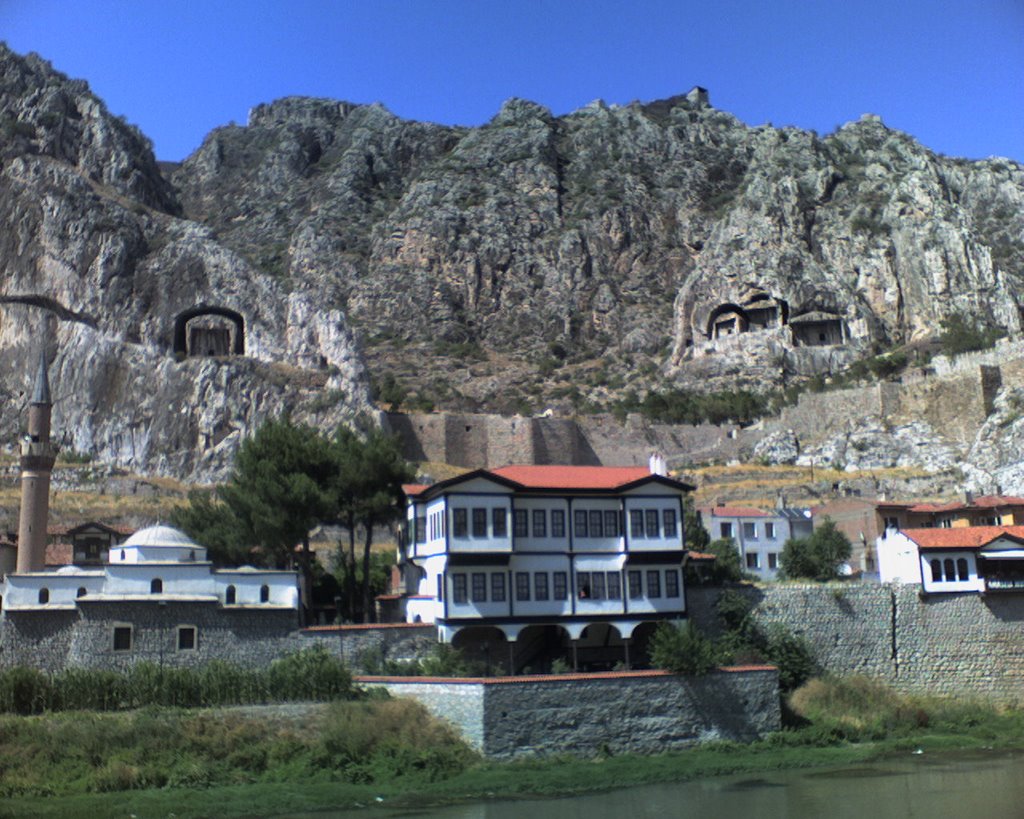Amasya
Amasya was a religious and political center for central Anatolia in Turkey. and there are many small mosques that date back to pre-Ottoman times. The Gok Medrese Camii is on the edge of town opposite the otogar, and has a türbe (mausoleum/shrine of a holy person) in front of it. There is a “house of suffering” that you can get to if you walk up the hill from the town square, which was an important Alevi pilgrimage spot, as its founder’s turbe is nearby. You can go into the “suffering house” now that it’s no longer in use, and explore the small cells men would live in for months at a time, with little food and water and outside contact, simply reading the Qur’an and meditating on it.
There are two separate wax museums, one dedicated to the 7 Padishahs and one dedicated to Anatolian life in the 16-19th centuries. Like everything else mentioned. Not really recommended, however.
Get in
The otogar is on the edge of city and has many major lines that come and go from Ankara and Istanbul all day long. Most of these lines will offer you a free service to the town square. There are also a few busses every day going every direction, to and from Izmir, Antalya, and Trabzon. To come and go from Samsun, the nearest city on the Black Sea coast, there are small Metro minibuses that leave several times a day.
Get around
Once you get a bus service or taxi to the town square, everything is within easy walking distance. If you are going on day trips to other villages in the region, you can find small privately-owned buses that come and go if you ask around.
For car rentals (if you’re interested in a day trip to Hattuşa, the Hittite capital, for example), there is a car rental/pet store very near the Train Station, and another near the bridge.
See
The major sights of the city include the whitewashed Ottoman houses lined by the river and the ancient Pontic rock tombs engraved on the side of the mountain overlooking the city.
Do
Stroll along the river walk along with Amasya’s townspeople. In the summer months, the street is closed at night because so many people are out.
Go to the already-mentioned tombs ( accessible by a staircase in the “old” section of town) and the castle. The castle is free to enter, but requires a car to get to it.
The Bimarhane, built during the Mongol period, was the first mental health research facility that used music to treat its patients. For the past 75 years or so, it had been the home of Amasya’s music conservatory in honor of its past, but has recently re-opened as a museum in tribute to the ground-breaking man who did research here.
Most buses stop near the The Amasya Belediye (Municipal) Museum. It’s a typical museum in Turkey, containing objects from the province that date from the early Greek period through the end of the Ottoman dynasty. Of particular note are the mummies from the Mongol period, preserved by the air of their mountain tombs. A bit gruesome but fascinating and unexpected.
Amasya’s largest mosque complex is dedicated to Beyazid II. It is on the riverside and a very prominent site in town. Today, the complex also houses the city library (formerly a law school) as well as a soup kitchen and a miniature museum of Amasya.
Amasya has several very old, nice hamams. Near the Bimarhame is Mustafa Bey hamami, which is a beautifully restored building that includes a swiss-style sauna room, and has service as good as any hamam in Istanbul for half the price. Yildiz hamam, in the old part of town, is dirty. Kumacik hamam, between the otogar and the town square on the riverside, is a small hamam which boasts of a pool. They are all single-sex, open to men from 6-10 AM, women 10AM-5PM, and men again 5PM-12. There are special days in the week for working women to come at night, and the weekends are generally reserved entirely for men. Check with the hamams ahead of time; if you are staying at a hotel they can call and ask for you.
